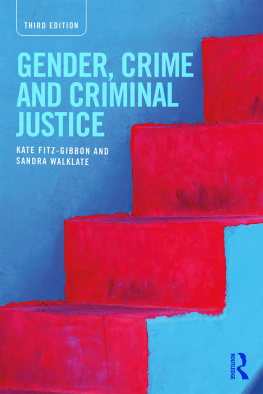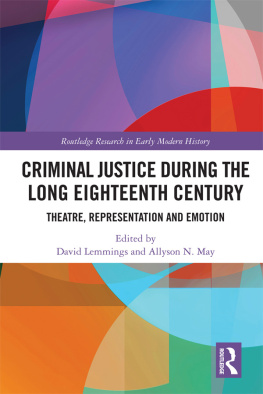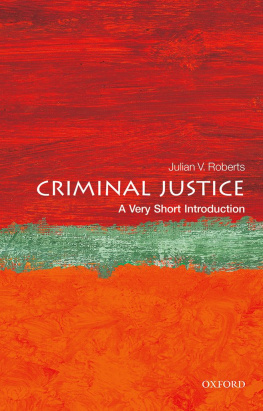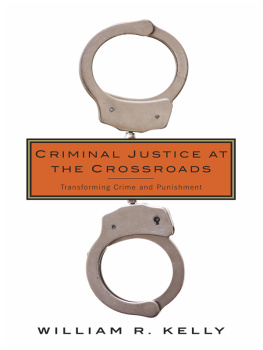Public Opinion, Crime, and Criminal Justice
CRIME & SOCIETY
Series Editor John Hagan
University of Toronto
E DITORIAL A DVISORY B OARD
John Braithwaite, Robert J. Bursik, Kathleen Daly, Malcolm M. Feeley, Jack Katz, Martha A. Myers, Robert J. Sampson, and Wesley G. Skogan
Public Opinion, Crime, and Criminal Justice, Julian V. Roberts and Loretta J. Stalans
Poverty, Ethnicity, and Violent Crime, James F. Short, Jr.
Great Pretenders: Pursuits and Careers of Persistent Thieves, Neal Shover
Crime and Public Policy: Putting Theory to Work, edited by Hugh D. Barlow
Control Balance: Toward a General Theory of Deviance, Charles R. Tittle
Rape and Society: Readings on the Problems of Sexual Assault, edited by Patricia Searles and Ronald J. Berger
F ORTHCOMING :
Women's Careers in Violent Crime: Casualties of Community Disorder, Deborah R. Baskin and Ira B. Sommers
Public Opinion, Crime, and Criminal Justice
Julian V. Roberts and Loretta J. Stalans
Crime & Society
First published 2000 by Westview Press
Published 2018 by Routledge
711 Third Avenue, New York, NY 10017, USA
2 Park Square, Milton Park, Abingdon, Oxon OX14 4RN
Routledge is an imprint of the Taylor & Francis Group, an informa business
Copyright 2000 Taylor & Francis
All rights reserved. No part of this book may be reprinted or reproduced or utilised in any form or by any electronic, mechanical, or other means, now known or hereafter invented, including photocopying and recording, or in any information storage or retrieval system, without permission in writing from the publishers.
Notice:
Product or corporate names may be trademarks or registered trademarks, and are used only for identification and explanation without intent to infringe.
Library of Congress Cataloging-in-Publication Data
Roberts, Julian V.
Public opinion, crime, and criminal justice / Julian V. Roberts
and Loretta J. Stalans.
p. cm.(Crime and society)
Includes bibliographical references.
ISBN 0-8133-2318-5 (hc) ISBN 0-8133-6793-X (pbk).
1. CrimeUnited StatesPublic opinion. 2. CrimeGreat Britain
Public opinion. 3. Criminal justice, Administration ofUnited
StatesPublic opinion. 4. Criminal justice, Administration of
Great BritainPublic opinion. 5. Criminal statisticsUnited
States. 6. Criminal statisticsGreat Britain. 7. Public opinion
United States. 8. Public opinionGreat Britain. I. Stalans,
Loretta J. (Loretta Jane) II. Title. III. Series: Crime & society
(Boulder, Colo.)
HV6789.R63 1997
364.973dc21
97-15795
CIP
ISBN 13: 978-0-8133-6793-4 (pbk)
To Kay Roberts and the teachers in my life
Julian V. Roberts
To Raymond B. and Diane T. Stalans for their strongly held opinions and their love
Loretta J. Stalans
The preparation of this book was aided by the research assistance of Pao Yang and the Department of Criminal Justice at Loyola University, who provided support for a research assistant. The authors extend their gratitude to Sylvie Chiasson from the University of Ottawa for her assistance in preparing the manuscript. Loretta Stalans also is grateful for the patient and loving support of her husband, Paul Yarnold.
Julian V. Roberts
Loretta J. Stalans
Public Opinion, Crime, and Criminal Justice
1
Introduction and Overview: Crime in the Public Eye
To the public, crime seems to be everywhere, from the boardrooms to the bedrooms of the nation, in peoples' homes and on their television screens. Americans worry about criminal victimization, are concerned about the proliferation of illegal drugs, and the transformation of many urban centres into "no-go" areas. But it is not just crime that engages the public's attention: The criminal justice response is equally interesting. Most Americans have seen footage of the assault on Rodney King in what became the most well-known amateur video since Zapruder's footage of the Kennedy assassination. The ensuing trials of the officers involved in the Rodney King case also fascinated the public. Rodney King, William Kennedy Smith, the Menendez brothersall these cases attracted prime time media coverage. Riveting though they were for the public, none have attracted the degree of media coverage or public interest than the Simpson murder trial which in 1995 attracted more media attention than any other news story in America. Well over one hundred million Americans watched television in anticipation of the verdict in that case. Millions more followed the case in other countries.
An indication of the degree of public concern about the crime issue can be found by examining poll data. In 1994, crime was identified as the number one problem confronting America (Maguire and Pastore, 1994). Fully 37 percent of the public endorsed this view, a much higher percentage than any other social problem, including unemployment or the economy. Examination of the historical record shows that concern over crime is greater nowand by a substantial degreethan ever before. In 1993 only 9 percent, and in 1992 only 5 percent of Americans identified crime as the number one national problem. In fact, this statistic had never been in excess of 10 percent since the question was first posed in 1980. The results are the same whether people are asked about the whole country or their own specific communities. When respondents were given a list of fifteen neighborhood problems, crime was identified more frequently than any other issue, including unemployment (Maguire et al ., 1993). In a poll published by Gallup as the U.S. Crime Bill passed in 1994, over 80 percent of Americans surveyed thought that crime was the most serious threat to individual rights and freedoms in America. Only 41 percent of respondents identified lack of economic opportunity as the most serious threat in this respect.
Another indication of the concern of Americans regarding the crime problem is to be found in their willingness to pay for additional criminal justice expenditures. Even though the justice system costs almost the country seventy-five billion dollars a year, fully three-quarters of the American public believe that too little is being spent to combat crime (Maguire and Pastore, 1995). This attitude has not changed appreciably in the past fifteen years: In 1980, 69 percent of the public held this opinion (Maguire and Pastore, 1995). Finally, it is important to note that the uneven distribution of criminal victimization means that fear or concern is also distributed differentially across the country. For example, Asian Americans are significantly more likely than African-Americans to identify crime as the most important problem facing their community (Maguire and Pastore, 1994).
This widespread public concern over crime in America is accompanied by a highly negative view of the criminal justice response. Here too, there has been a shift in public opinion. The last few years have witnessed a significant decline in public support for the criminal justice system. When Americans were asked in 1994 how much confidence they had in various institutions, the criminal justice system received the lowest ratings. Over half the sample said that they had "a great deal" or "quite a lot" of confidence in the U.S. military and the Church, while only 20 percent expressed a similar degree of confidence in the criminal justice system. Over 40 percent of respondents acknowledged that they had very little or no confidence in the justice system (Maguire and Pastore, 1995). Only one quarter of Americans believe that equal justice exists all or most of the time (Keeva, 1994).








